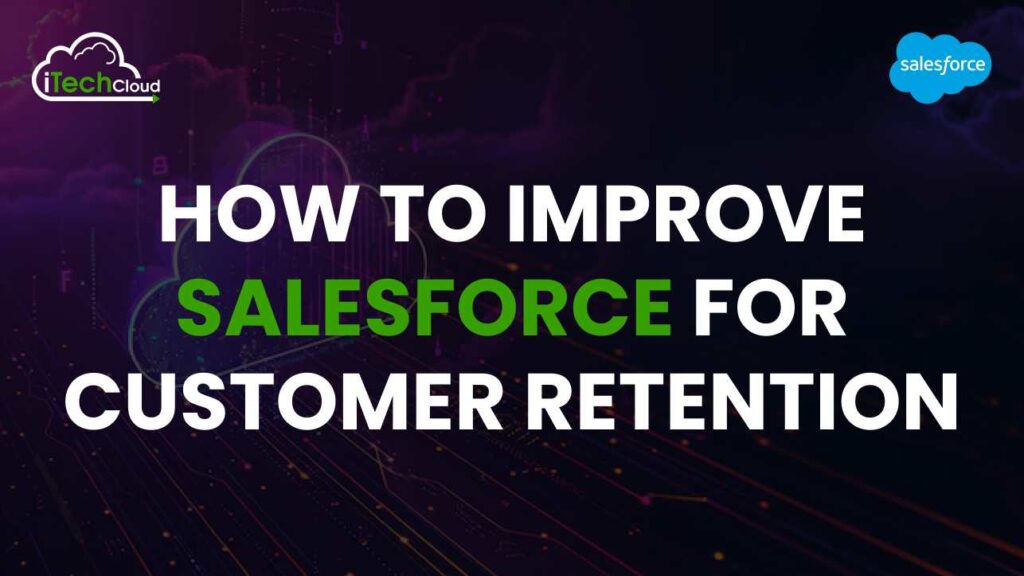How to Improve Salesforce for Customer Retention

Improving Salesforce for customer retention involves leveraging its extensive tools and capabilities to create a customer-centric approach that enhances satisfaction and loyalty. Here’s a detailed guide on how to achieve this:
1. Personalize Customer Experiences
Understand Customer Data
Salesforce provides a unified view of customer data, including purchase history, interactions, preferences, and feedback. By analyzing this data, businesses can gain deep insights into customer behavior and preferences.
Segmentation
Use Salesforce’s segmentation capabilities to group customers based on various criteria such as demographics, purchase history, and engagement levels. This allows for more targeted marketing and communication strategies.
Tailored Communication
Salesforce Marketing Cloud to send personalized emails, messages, and offers. Dynamic content and personalized journeys ensure that customers receive relevant information that resonates with their needs and interests.
2. Customer Service
Omni-Channel Support
Salesforce Service Cloud integrates various communication channels such as phone, email, chat, and social media into a single platform. This ensures that customers receive consistent and efficient support regardless of the channel they choose.
AI-Powered Support
Implement Salesforce Einstein AI to provide intelligent support solutions. Einstein Bots can handle common inquiries, allowing human agents to focus on more complex issues. Predictive analytics can help identify potential problems before they escalate.
Knowledge Base
Develop a comprehensive knowledge base within Salesforce to empower customers to find answers to their questions independently. This not only enhances the customer experience but also reduces the load on support teams.
3. Gather and Analyze Customer Feedback
Surveys and Feedback Forms
Utilize Salesforce’s survey tools to regularly gather feedback from customers. Post-purchase surveys, NPS (Net Promoter Score) surveys, and feedback forms can provide valuable insights into customer satisfaction and areas for improvement.
Sentiment Analysis
Incorporate sentiment analysis tools to gauge customer emotions and opinions from their interactions and feedback. This helps in identifying unhappy customers early and addressing their concerns promptly.
4. Develop Loyalty Programs
Rewards and Incentives
Create and manage customer loyalty programs within Salesforce. Offer rewards, discounts, and exclusive offers to loyal customers to incentivize repeat purchases and long-term engagement.
Gamification
Introduce gamification elements such as points, badges, and leaderboards to make the loyalty programs more engaging. Salesforce’s integration capabilities can help in seamlessly incorporating these elements into the customer journey.
5. Proactive Customer Engagement
Automated Reminders and Follow-Ups
Use Salesforce’s automation tools to set up reminders and follow-ups for important customer interactions. This could include reminders for renewals, follow-ups on abandoned carts, or check-ins after a purchase.
Content Marketing
Implement a robust content marketing strategy through Salesforce Marketing Cloud. Share valuable content such as how-to guides, product updates, and industry news to keep customers engaged and informed.
6. Map Customer Journeys
Journey Builder
Utilize Salesforce’s Journey Builder to create detailed customer journey maps. This helps in understanding and optimizing every touchpoint in the customer lifecycle, from awareness to advocacy.
Lifecycle Stages
Identify and segment customers based on their lifecycle stages (e.g., new customers, active customers, lapsed customers). Tailor your engagement strategies to suit each stage, ensuring relevant and timely interactions.
7. Data-Driven Decision Making
Analytics and Reporting
Salesforce’s robust analytics and reporting tools to monitor key metrics related to Salesforce for Customer Retention. Regularly track customer lifetime value, churn rate, and engagement metrics to make informed decisions.
Predictive Analytics
Use Salesforce Einstein Analytics to predict future customer behavior and trends. This can help in identifying at-risk customers and devising strategies to retain them before they churn.
8. Focus on Customer Success
Customer Success Teams
Establish a dedicated customer success team within Salesforce to proactively manage customer relationships. This team should focus on helping customers achieve their goals with your products and services.
Onboarding Programs
Develop comprehensive onboarding programs to ensure new customers get the most out of your products. Provide training, resources, and regular check-ins to facilitate a smooth onboarding process.
9. Integrate and Automate Processes
Integrate with Third-Party Tools
Salesforce’s extensive integration capabilities allow you to connect with various third-party tools and platforms. Integrate with CRM, ERP, and other business systems to ensure seamless data flow and a holistic view of customer interactions.
Automation Workflows
Implement automation workflows to streamline repetitive tasks and processes. Use Salesforce’s Process Builder and Flow Builder to automate tasks such as data entry, customer follow-ups, and reporting.
10. Continuous Improvement
Regular Audits and Updates
Conduct regular audits of your Salesforce setup to identify areas for improvement. Ensure that your data is clean, processes are efficient, and tools are up-to-date.
Customer Retention Metrics
Regularly review and analyze Salesforce for Customer Retention metrics. Use this data to refine your strategies and implement changes that drive better customer outcomes.
Conclusion: Salesforce for Customer Retention
Improving Salesforce for customer retention requires a multi-faceted approach that combines personalization, enhanced service, proactive engagement, and data-driven decision-making. By leveraging Salesforce’s powerful tools and features, businesses can create a seamless and satisfying customer experience that fosters loyalty and long-term Salesforce for Customer Retention. Implementing these strategies will not only help in retaining existing customers but also in attracting new ones, ultimately driving business growth and success.

